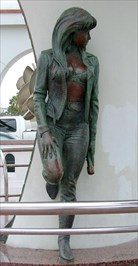This week's readings on Selena were enlightening but I think the author fell short of fully demonstrating the impact of the Selena cult. It's clear Selena did play a major role in defining a Latino market in the 1990s that corporations and media very quickly realized they could exploit. The perfect example of this is the fact that People en Español was launched within a year of the record sales that the Selena commemorative issue had garnered.
This point alone is fascinating, and the fact that corporations misjudged the Latino population by producing a Spanish-only publication when, in reality, many second generation and later Latinos do not speak Spanish. This commodification of Latinidad, the missteps, and the ways it played out in various communities would have been a valuable contribution of the book, but Paredez barely touches upon these issues. Instead, she quickly jumps to making larger and, at times, unsubstantiated claims about Selena's role in helping to define modern Latinidad.
The major claim I take issue with is the belief that there was some unique fetishization of the deaths of young Latinas - Frida, Evita, and Selena being Paredez's primary examples. Kurt Cobain and Tupac Shakur, two male musicians who died tragically within a few years of Selenas, made as many waves among their followers. And John F. Kennedy, Buddy Holly, and numerous other stars and public figures before them had captured the hearts and minds of the American public through their early, tragic deaths. So, I think that the posthumous Selena cult can't be solely ascribed to any kind of fixation with dead Latinas, as Paredez argues that it does. She also claims that the Juarez femicides and that all Latina deaths can be understood through Selenidad:
This point alone is fascinating, and the fact that corporations misjudged the Latino population by producing a Spanish-only publication when, in reality, many second generation and later Latinos do not speak Spanish. This commodification of Latinidad, the missteps, and the ways it played out in various communities would have been a valuable contribution of the book, but Paredez barely touches upon these issues. Instead, she quickly jumps to making larger and, at times, unsubstantiated claims about Selena's role in helping to define modern Latinidad.
The major claim I take issue with is the belief that there was some unique fetishization of the deaths of young Latinas - Frida, Evita, and Selena being Paredez's primary examples. Kurt Cobain and Tupac Shakur, two male musicians who died tragically within a few years of Selenas, made as many waves among their followers. And John F. Kennedy, Buddy Holly, and numerous other stars and public figures before them had captured the hearts and minds of the American public through their early, tragic deaths. So, I think that the posthumous Selena cult can't be solely ascribed to any kind of fixation with dead Latinas, as Paredez argues that it does. She also claims that the Juarez femicides and that all Latina deaths can be understood through Selenidad:
“Latina feminism enables the acknowledgement an the examination of the relationships between the frequently appropriated, once glamourous dead Latina bodies of Evita, Frida, and Selena and other, more quotidian though no less significant Latina deaths that have occurred as the result of welfare reform, border militarization, and the post-NAFTA economy."
In the sections we read, at least, Paredez very loosely references "Latina feminism" in drawing this link, without ever saying exactly what that means and why it creates a relationship between the two very disparate kinds of killing. This brings me to my main problem with the book as a whole - and serves as a good example of how theory and cultural studies itself can be poorly done. Paredez references theories to support some pretty far-fetched claims, but never really articulates how that theory supports the claims she's making. I also think her gaze is too singularly focused on Selena's death and her cult following without asking larger questions about death/celebrity fetishization and the historical/cultural context of death and morning within Hispanic communities. Those things might end up being irrelevant but her failure to really address them weakens the books as a whole.
 |
| Selena statue in Corpus Christi |

No comments:
Post a Comment